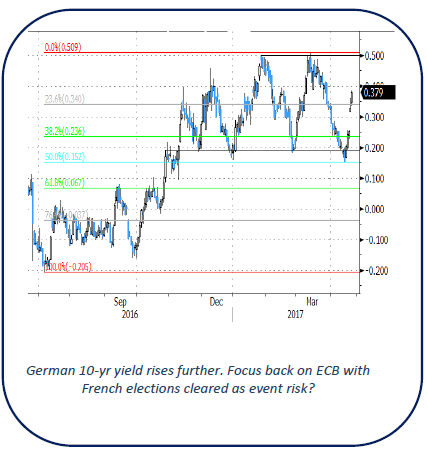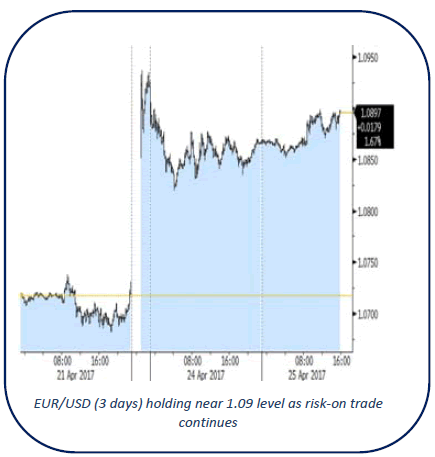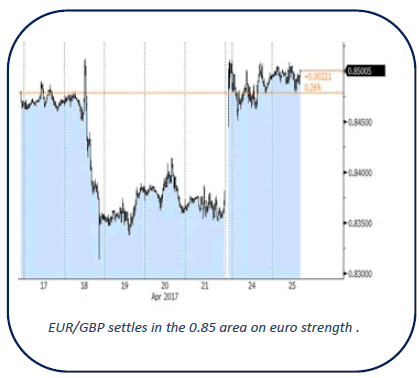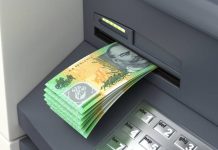Headlines
European equities didn’t face the traditional setback after yesterday’s stellar gains. Instead they added another 0.5%. US stock markets opened positive as well (+0.5%) with the Dow Jones outperforming (+0.1%). A lot of huge corporates posted good Q1 earnings (Eli Lilly, Caterpillar, McDonalds, Dupont…)
The Richmond Fed Manufacturing index declined less than expected in April, from 22 to 20 (vs 16 expected). Consumer confidence disappointed though, falling from a downwardly revised 124.9 to 120.3 in April (vs 122.5 expected). Especially the "expectations" component faced a setback. Housing data were better than forecast.
Kikuo Iwata, deputy governor of the central bank, says it’s too early for the Bank of Japan to reveal its simulations for exiting its monetary easing program as its 2% price target remains distant.
Banks across the euro zone are set to tighten access to credit for companies in the second quarter but lending volumes are still seen rising, helped by ultralow rates, the ECB indicated in its bank lending survey. Corporate credit standards eased somewhat in the first quarter, broadly in line with earlier expectations.
The German government has slightly raised its growth forecasts for Europe’s biggest economy for this year and next due to increased optimism about rising global demand, two senior government officials told Reuters. The government now expects gross domestic product (GDP) to expand by 1.5% in 2017 and by 1.7% in 2018.
Caterpillar cut its forecast for full year earnings per share because of higher restructuring costs, even as it forecasts stronger than expected sales and revenues for 2017, which could suggest a recovery in global markets for construction, energy and mining.
Rates
French elections cleared. focus back on ECB exit?
Global core bonds lost ground today. German Bunds underperformed US Treasuries at the long end of the curve suggesting that European investors’ focus turns to the ECB’s normalisation process with French elections out of the way. We think that the ECB will calibrate its APP again later this year by lowering the amount of monthly purchases again. We don’t expect any communication at Thursday’s policy meeting though. Heavy supply was additionally negative today for bonds (see below). The European eco calendar (empty), stock markets (0%-0.5%), and oil prices (flat) didn’t provide impetus for trading. US eco data printed mixed. Housing data and the Richmond Fed manufacturing index surprised on the upside of expectations, but the more important consumer confidence disappointed. The US Note future made a small uptick after the release, but we don’t expect sustained gains.
At the time of writing, the German yield curve bear steepens with yields 1.4 bps (2-yr) to 6.7 bps (30-yr) higher. Changes on the US yield curve vary between +2.9 bps (2-yr) and +4 bps (5-yr). On intra-EMU bond markets, 10-yr yield spread changes versus Germany range between -3 bps (Portugal) and +1 bp (Italy). Greece slightly outperforms (-6 bps).
The German Finanzagentur held a €4B 2-yr Schatz auction (0% Mar2019). Total bids amounted only €3.78B, below the €5.08B average at the previous 4 Schatz auctions and below the amount on offer (real bid cover 0.9). The Bundesbank set aside €0.78B for secondary market operations, resulting in an official bid cover of 1.2. The auction yield (-0.69%) was the highest since November last year. The Dutch debt agency tapped the 10-yr DSL (€2.1B 0.75% Jul2027) for up to €3B. The amount sold was in the lower half of the €2-3B target range. The US Treasury starts its end-of-month refinancing operation with a $26B 2-yr Note auction. Currently, the WI trades around 1.27%.

Currencies
USD/JPY extends gains; EUR/USD holds near 1.09
The post-Macron risk-on trade continued today, but, understandably, at a slower pace than yesterday. Equities and especially core bond yields trended further north. The risk-on sentiment had again a mixed impact on the dollar as both EUR/USD and USD/JPY trended cautiously higher. EUR/USD is retesting the 1.09 big figure. The USD/JPY upleg accelerated during the day. The pair is changing hands in the 110.70 area.
Overnight, Asian equities eked out more gains even as global markets pondered the impact of President Trump’s tax proposals and a spending bill that the needs to be approved soon to avoid a government shutdown. For now, it didn’t hamper the global risk rally. The yen weakened slightly after yesterday evening’s setback. USD/JPY returned to the 110 area. EUR/USD held near 1.0865, where it was most of yesterday’s session.
European markets continued the Asian trend. European equities maintained a positive intraday bias. Of course, the gains were modest as investors digested yesterday’s steep gains. Core bond yields rose another few basis points. Interest rate differentials widened slightly in favour of the dollar at the short end of the curve but narrowed at the long end. EUR/USD held a narrow range just below 1.09. So, the post-Macron top remained within reach. USD/JPY also maintained a cautious upward bias, drifting to the 110.50 area.
Risk sentiment remained positive early in US dealings. US equity futures were supported by strong results for several US bellwethers including Dupont, Caterpillar and others. Initially, the risk on trade supported USD/JPY, EUR/JPY and EUR/USD at the same time. However, strong US housing data gave the dollar a better bid capping the topside of EUR/USD as the pair retested the 1.09 area. USD/JPY trended higher to the 110.75 area going into the US midmorning data. These data were mixed. US new home sales were very strong and the Richmond Fed manufacturing index decline less than expected (from 22 to 20). However, consumer confidence dropped more than expected. The immediate impact on the dollar is limited. EUR/USD again tries to regain the 1.09 big figure. USD/JPY remains well bid in the 110.70 area.

EUR/GBP off the recent lows on euro strength
The March budget data were the only UK specific data on the agenda today. The March deficit was slightly wider than expected at £5.1 bln. Disappointing VAT revenues might be another indication that UK consumers are pressured by the rising prices. As usual, the impact of the report on sterling trading was limited. EUR/GBP still held a very tight sideways range around the 0.85 big figure. Cable traded with a slight upward bias intraday and returned north of 1.28 (currently 1.2820). This cross rate also stabilized within the tight range that was in place since UK PM announced early elections last week.















